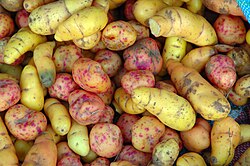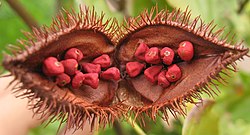Neglected and underutilized crop
Neglected and underused crops are domesticated plant species that have been used for centuries for their food, fibre, fodder, oil or medicinal properties, but have become less important over time. There are many other terms to describe these crops. Usually, these crops are underused, because there are other, similar crops that have better properties, such as a longer shelf life. Their nutritional value may be unrecognized. Sometimes, they may also have an image problem: They may be seen as famine food, or "poor people's food". Sometimes, they have become neglected, because the way agriculture is done has changed. Some crops have been neglected so much that genetic erosion of their gene pool has become so severe that they are often seen as lost crops.[1]
The demand that certain crops have a given set of properties changes over time. To be able to cope with climate change, it may be necessary to have crops which are better adapted to the climate in which they are grown. Many neglected crops have been reconsidered, because they have useful properties. Examples are oil palm, soybean, and kiwifruit. They used to be neglected, and are now grown worldwide. That way, many species can contribute to food security, or a more varied diet. They may also be better for health.
It is often difficult to increase the production of these crops, and to make them suitable for large-scale agriculture. Nevertheless, may of these sepcies can contribute to food security. They can also provide for a more varied diet and be good for nutrition. Finally they can provide environmental services.
For people who are allergic, or who cannot use the regular crop for other reasons, such crops can be an alternative. People may also prefer them for an active and healthy life, especially during famine.
Just three crops - maize, wheat and rice - account for about 50% of the world's consumption of calories and protein.[2] About 95% of the world's food needs are provided by just 30 species of plants.[3] In contrast, at least 12,650 species names have been called edible.[4] Neglected and underutilized plants are those that could be - and, in many cases, historically have been - used for food and other uses on a larger scale.
Such crop species have also been described as "minor", "orphan", "promising" and "little-used".
Examples
Researchers do not agree on when a crop is underutilized or neglected. In that context, neglected means that the crop hasn't seen much interest from research and development; politicians and lawyers did little to support the conservation of the crop.
Underutilisation means that the crop isn't used very much, in a particular geographic area. The crop can contribute to better diets, or better ways of production. Just because it is little used in one geographic area does not necessarily mean that this is the case for other geographic areas.[1]
Cherimoya (Annona cherimola) on sale in Cali, Colombia. In left background: domestically produced mangosteen (Garcinia mangostana)
Bambara groundnut (Vigna subterranea) from Buzi district in Mozambique
Ziziphus mauritiana (dry fruits) for sale at the Luangwa turn-off on Great East road, Zambia.
Bixa orellana fruit open, showing the seeds from which annatto is extracted, photographed in Campinas, Brazil
Neglected And Underutilized Crop Media
Cherimoya (Annona cherimola) on sale in Cali, Colombia. In left background: domestically produced mangosteen (Garcinia mangostana)
Bambara groundnut (Vigna subterranea) from Buzi district in Mozambique
Ziziphus mauritiana (dry fruits) for sale at the Luangwa turn-off on Great East road, Zambia.
Ipomoea aquatica photographed in the Sunday Market, Kuching, Sarawak, Malaysia
Ulluco tubers (Ullucus tuberosus) for sale in southern Peru
Bixa orellana fruit open, showing the seeds from which annatto is extracted, photographed in Campinas, Brazil
Related pages
References
- ↑ 1.0 1.1 J. T. Williams; N. Haq (2002). Global research on underutilized crops - an assessment of current activities and proposals for enhanced cooperation. Southampton, UK: International Centre for Underutilised Crops. ISBN 978-92-9043-545-7. Retrieved 21 August 2013.
- ↑ FAO (1997). The State of the World's Plant Genetic Resources for Food and Agriculture (PDF). Rome: FAO.
- ↑ J. R., Harlan (1975). Crops and Man. Wisconsin: Crop Science Society of America.
- ↑ Kunkel, G. (1984). Plants for Human Consumption. Koenigstein, Germany: Koeltz Scientific Books.














